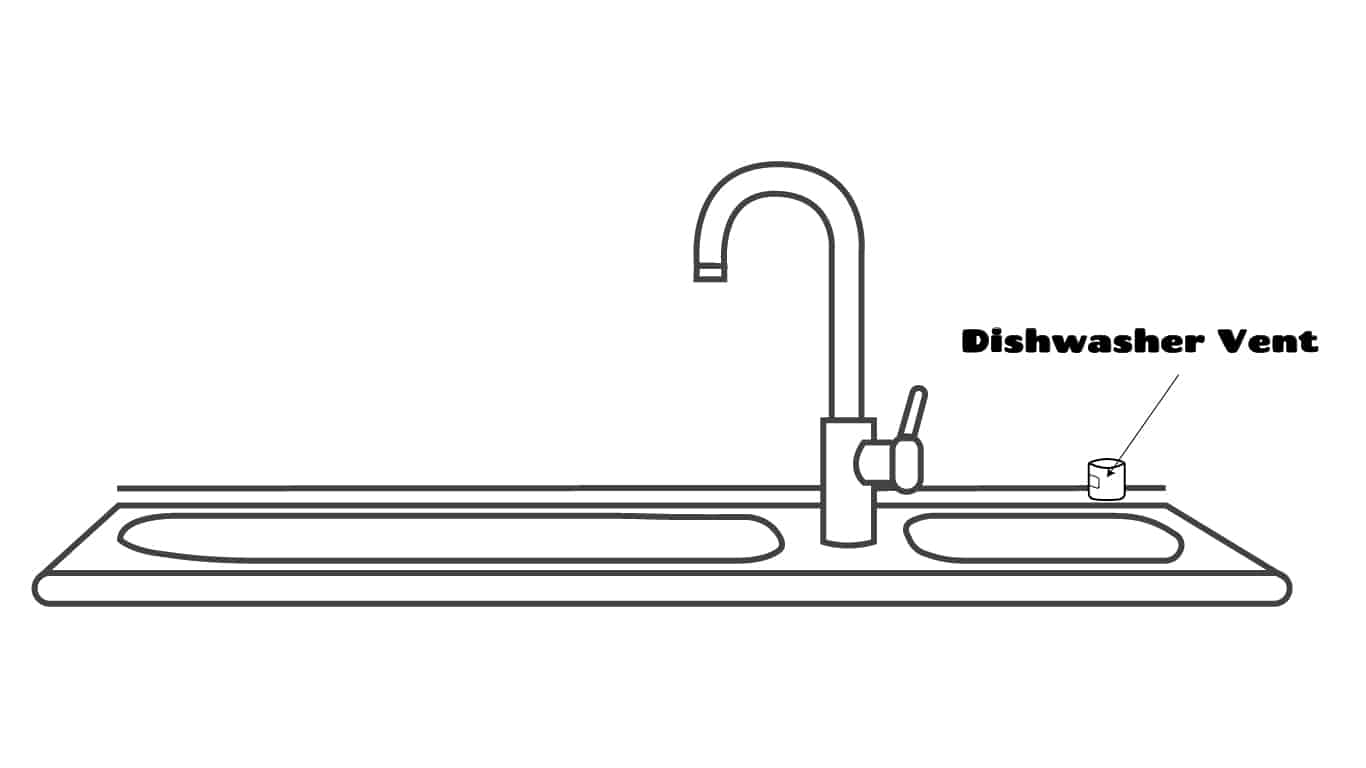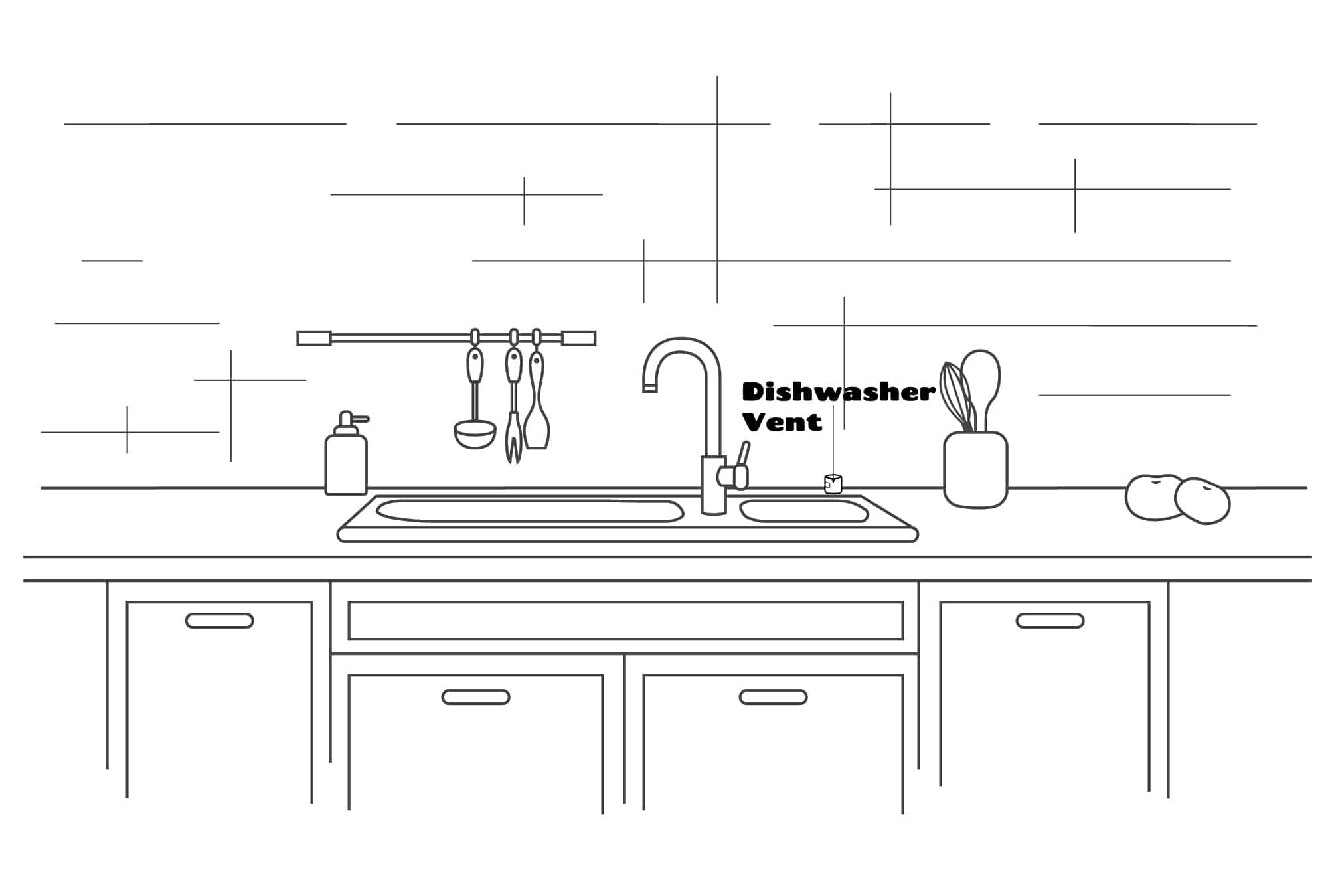Although a dishwasher is a relatively unassuming appliance, ignoring its exhaust vent can have serious consequences. When steam becomes trapped inside or around the dishwasher due to a lack of ventilation, it can cause mold, mildew, and even warping of your kitchen cabinets due to excess moisture.
It’s advised that you install a dishwasher vent or air gap as a safety precaution. Some areas may even mandate dishwasher vents as a way to prevent water from entering a clogged sewer line.
In this guide, I’ll explain what a dishwasher vent is and how it works, the dangers of not having a working vent, and how to maintain the vent.
What Is a Dishwasher Vent?

Installing a dishwasher vent, also known as an air gap, on a nearby countertop or sink is a necessary safety precaution. In order to prevent contaminated water from the sink from entering the dishwasher or the plumbing system, a filter has been installed.
The air gap is a small cylinder with two ports: one for the dishwasher’s drain hose and another for the house’s primary drain. The water from the dishwasher goes into an air gap before going into the regular plumbing system.
How Does a Dishwasher Vent Work?
Dishwashers are equipped with pumps that force water out of the appliance and down the drain hose whenever they are in use. The dishwasher’s water drains into the air gap, which connects to the house’s plumbing and, from there, to the main drain, septic tank, or sewer.
Separation from the house’s plumbing helps stop dirty water from reentering the dishwasher through a vent called an air gap. The air gap prevents water from overflowing and causing damage if the dishwasher’s drain hose becomes clogged. The air gap will also serve as a barrier to stop dirty water from reentering the dishwasher in the event of a plumbing issue, such as a clogged drain or sewer line.
Do You Need a Dishwasher Vent?
Depending on where you live, you may need to get a permit from the local building department in order to install a dishwasher in your home. The vent must be connected to the home’s plumbing system in a specific way and must be installed in a specific location, such as near the sink or on the countertop, according to the requirements.
Additionally, there is a required distance between the air gap and the drain, sink, or another similar opening. The dishwasher vent should be installed by a professional plumber to ensure it is in accordance with local building codes and functions properly.
What Can Happen If You Don’t Have a Dishwasher Vent?
The consequences of not installing a vent for a dishwasher can be disastrous. When there is no air gap, dirty water from the sink can flow back into the dishwasher, potentially contaminating the dishes and the entire system. It can also cause problems with the plumbing and dishwasher in your home.
If the hose connecting the dishwasher to the sink becomes clogged, the resulting overflow of water could flood the kitchen and other rooms. Also, if there isn’t an air gap, dirty water can flow back into the dishwasher if there’s a clog in the drain or sewer line. It’s also possible to incur fines for failing to comply with local building regulations by failing to install a dishwasher vent.
How to Install a Dishwasher Vent
The basic procedure for putting in a vent for a dishwasher is as follows:
- Find a convenient location for the air gap, which is usually a counter or sink close to the sink when a dishwasher is being used.
- Create an access point for the air gap by cutting a hole in the counter or sink.
- Join the air gap inlet with the drain hose from the dishwasher.
- Join the air gap’s discharge to the house’s piping system, usually the sink’s tailpiece or the garbage disposal’s discharge hose.
- Tighten the mounting nut to keep the air gap in place, and then test for air leaks.
Tips for Installing a Dishwasher Vent
By following these tips, you can ensure that your dishwasher vent is properly installed and functioning, which will provide the necessary protection for your home and dishwasher.
- Consult local building codes: It is important to check local building codes before installing a dishwasher vent to make sure you are in compliance and to learn about any requirements unique to your area.
- Hire a licensed plumber: A professional plumber will be able to install a dishwasher vent in accordance with all applicable regulations.
- Measure twice, cut once: Take precise dimensions of the space where the air gap will be installed. Failing to do so may require purchasing a new vent and supplies.
- Use Teflon tape: Teflon tape can be used to create a watertight seal and prevent leaks on the threads of the air gap and the drain hose. It’s generally advised that you use a bit more Teflon tape than you think you’ll need, so keep at least 2 or 3 rolls on hand.
- Keep the air gap close to the dishwasher: For convenience’s sake, the air gap shouldn’t be placed too far from the dishwasher’s location. In addition to convenience, this means that backed-up water will have a shorter distance to travel.
- Test for leaks: After installation, run a dishwasher cycle and check for any leaks. If you notice leaks, you may have to deconstruct the vent and put it back together again more carefully.
How to Maintain a Dishwasher Vent
Here are some tips on how to take care of the air gap or vent in your dishwasher:
- Regularly check for leaks: Always make sure there are no leaks in the air gap or where the dishwasher connects to the plumbing in your home. In the event of a leak, have a plumber attend to the problem immediately.
- Keep the air gap clean: Remove any buildup of debris from inside the air gap by cleaning it on a regular basis. Any small, pointy object, like a toothpick or pipe cleaner, will do to clear out the gunk.
- Keep the dishwasher clean: Make sure the filters and spray arms of the dishwasher are free of any debris or food particles. This will ensure that the air gap functions properly and that the drain hose does not become clogged.
- Inspect the air gap for any damage: Look for cracks or corrosion in the air gap to indicate damage. It is recommended that a plumber be called in to replace the air gap if any damage is discovered.
- Keep the area around the air gap clean: Regularly wiping down the counter or sink near the air gap will keep the area clean. This will aid in keeping the air gap clear of debris buildup.
Can You Hide a Dishwasher Vent?
Not really. A dishwasher vent is a fixture near your kitchen sink that gets rid of the water before it can enter your clogged sewer line. Hiding it can lead to a hidden accumulation of dirty water or ineffective drainage.
That said, there are two alternatives to help semi-conceal the dishwasher vent—getting a high loop or a standpipe.
The high loop in a dishwasher serves the same purpose as an air gap. It aids in the separation of muddy water from potable water. Essentially, it’s a system in which water flows backward. Here, a raised area under the sink serves as the path taken by the drain pipe. There are no instances of this method being against plumbing regulations anywhere.
While standpipes are more commonly associated with washing machines, they are also sometimes used in place of air gaps in dishwashers. They are not as simple as a high dishwasher loop or air gap and may require additional plumbing (and money) to install. If you want to avoid having your house smell like a sewer, don’t put it under the sink.






